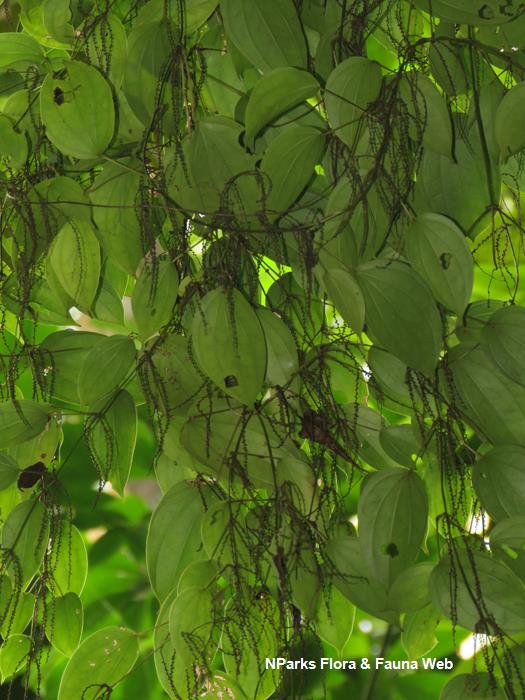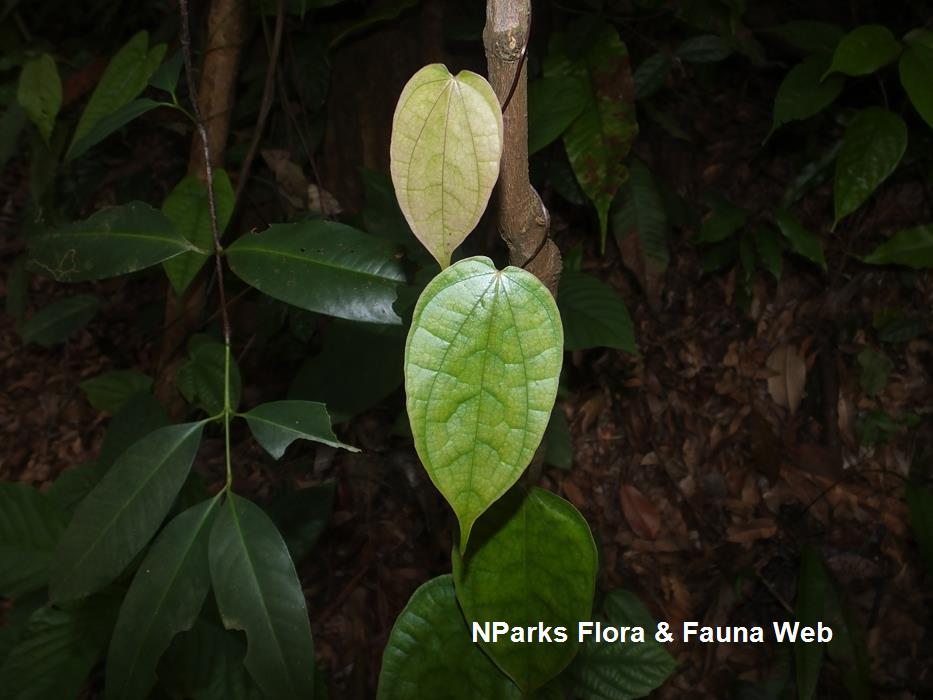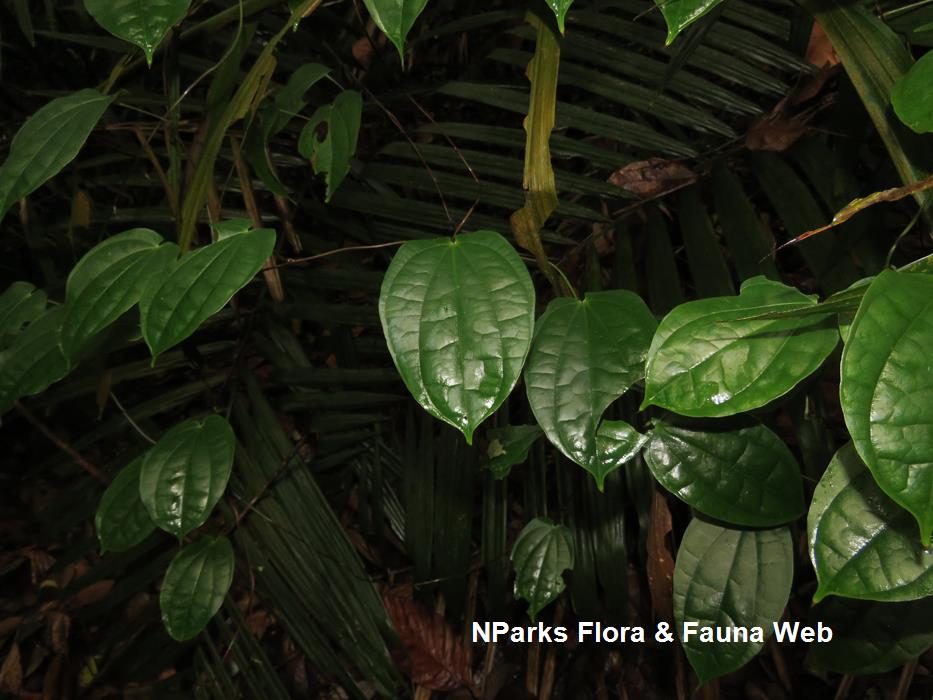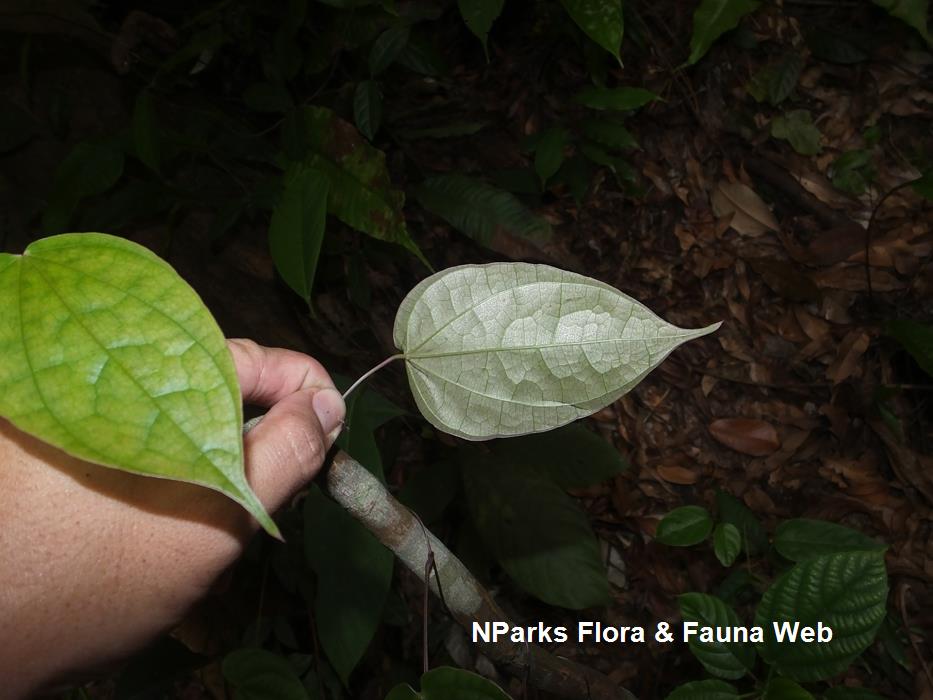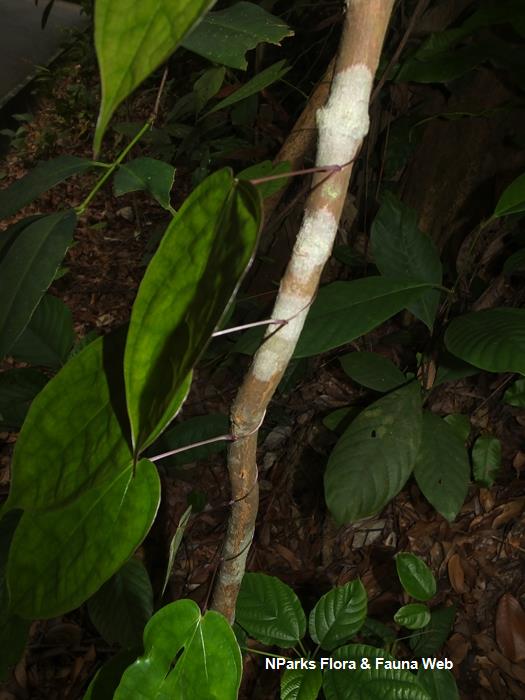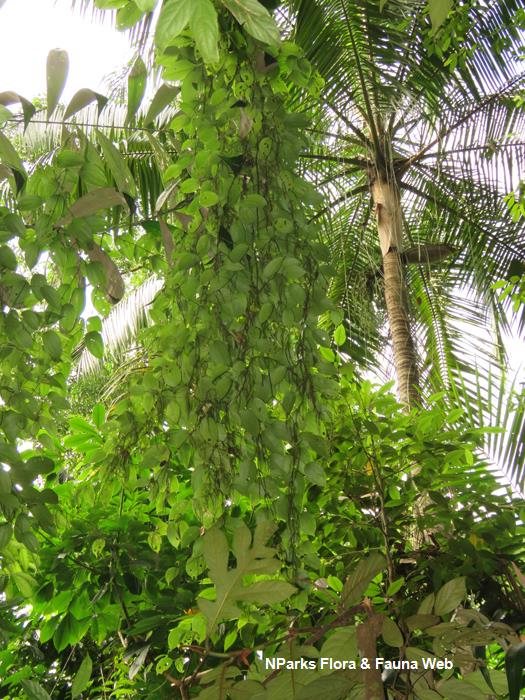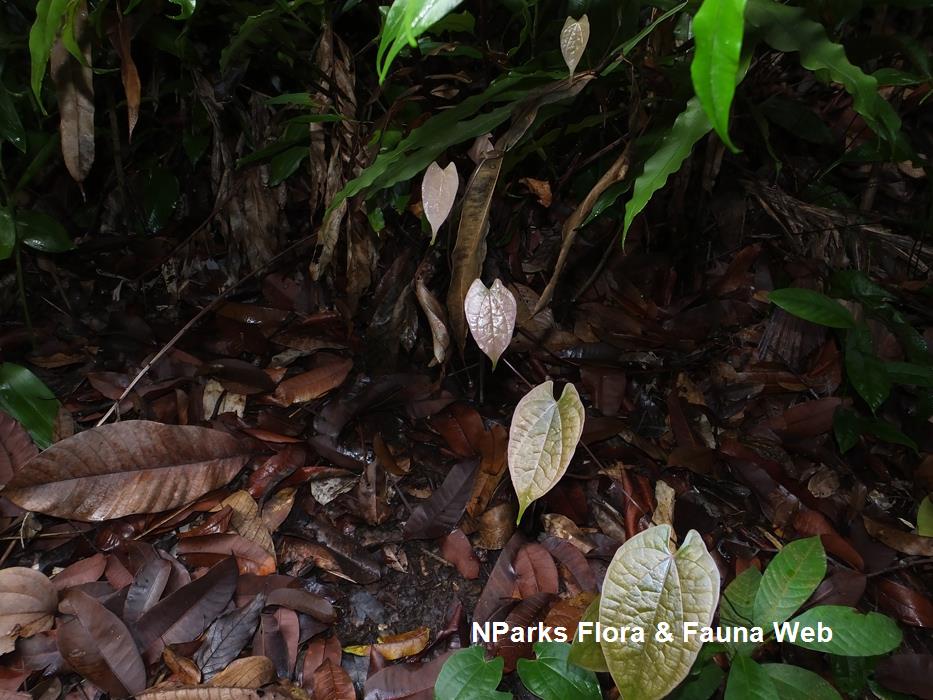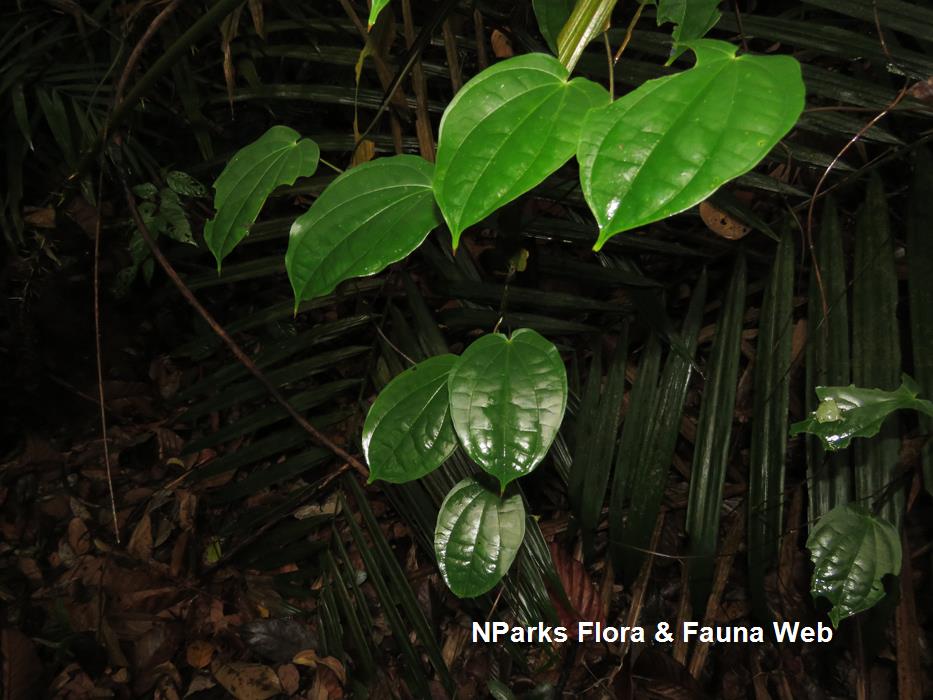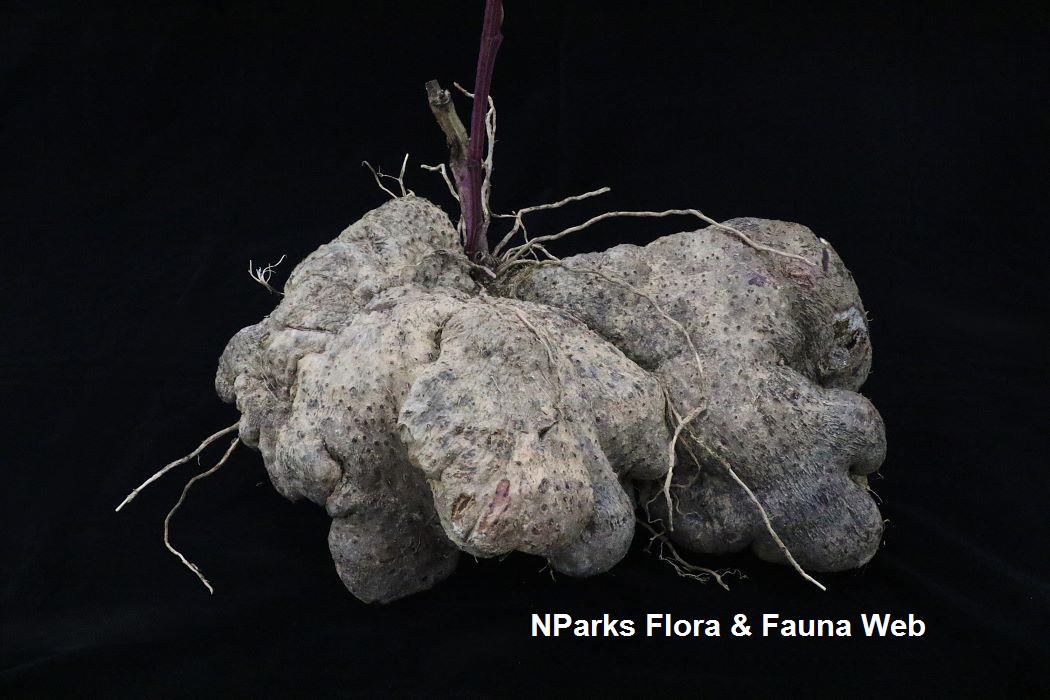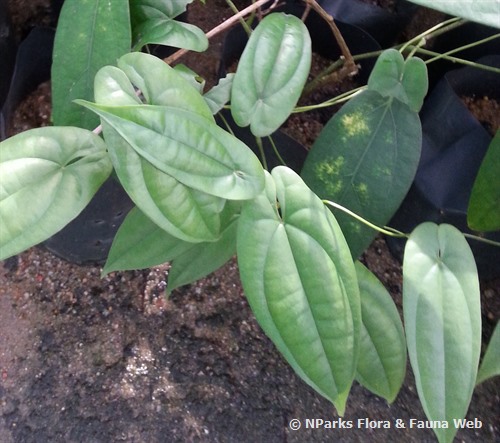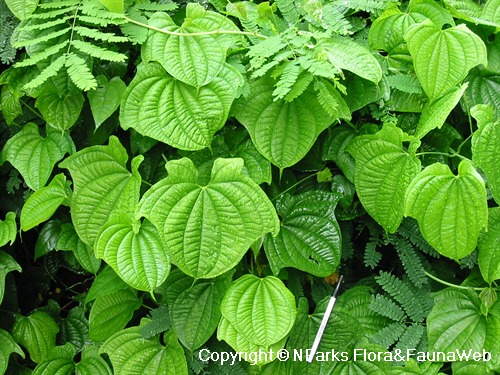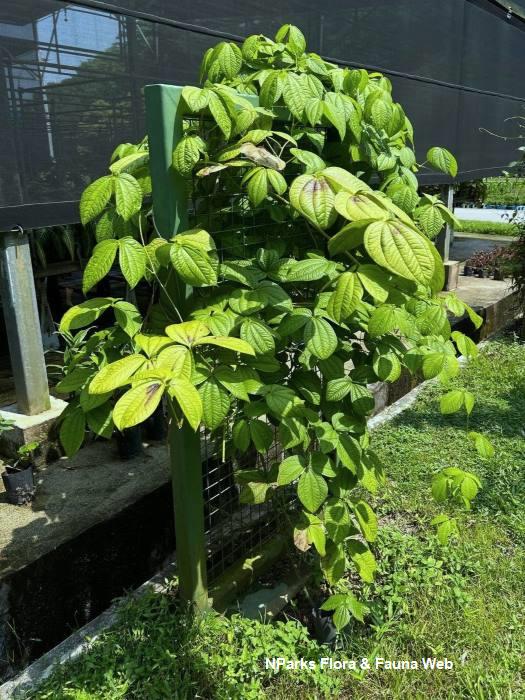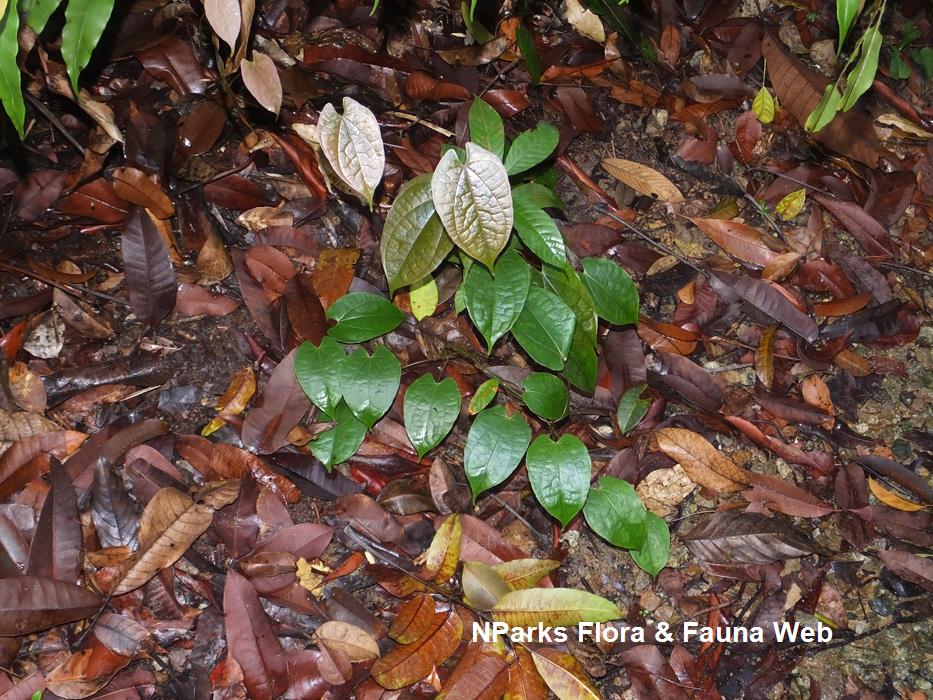
Back
Dioscorea tenuifolia Ridl.
| Family Name: | Dioscoreaceae |
| Synonyms: | Dioscorea orbiculata var. tenuifolia (Ridl.) Thapyai <3> |
Dioscorea tenuifolia is a native climber that can reach 30 m in height. It produces smooth, thin, lance-shaped to broadly egg-shaped leaves, and pendulous inflorescences that occur either individually or as a compound spike, depending on the sex of the flowers. The fruit is a capsule with three lobes, splitting when ripe to reveal wind-dispersal winged seeds. It also produces underground tubers that are presumably edible when cooked.
Name
Classifications and Characteristics
| Plant Division | Angiosperms (Flowering Seed Plants) (Monocotyledon) |
|---|---|
| Plant Growth Form | Climber |
| Lifespan (in Singapore) | Perennial |
| Mode of Nutrition | Autotrophic |
Biogeography
| Native Distribution | Thailand, Peninsular Malaysia, Singapore, Indonesia (Sumatra) |
|---|---|
| Native Habitat | Terrestrial (Primary Rainforest) |
| Preferred Climate Zone | Tropical |
| Local Conservation Status | Native to Singapore (Least Concern (LC)) |
Description and Ethnobotany
| Growth Form | It is a perennial, herbaceous climber that may reach 10 m in height. It has a twining growth habit. |
|---|---|
| Foliage | The leaves are smooth, green with a lighter underside, lance-shaped to broadly egg-shaped, measuring up to 12.5 cm long and 10 cm wide. The leaves are usually opposite but occasionally sub-opposite or alternate towards the base of the stem. The leaves are thin, either herbaceous or papery in texture. |
| Stems | The stems are smooth except for immature axillary buds that are covered in dense hairs. The stem base is loosely covered in prickles. The stem climbs by twining anti-clockwise up tree trunks or vertical supports. |
| Flowers | The inflorescence is a pendulous spike, occurring individually or as a compound spike per node for male inflorescences (up to 30-45 cm in length) or individually per node for female inflorescences (up to 20 m in length). Each inflorescence may hold up to 40 flowers. The flower is imperfect, having six small tepals (petals and tepals that are indistinguishable from one another) with floral bracts, and either male or female reproductive organs. Male inflorescences are occasionally infected with galls. |
| Fruit | The fruit is a capsule (a type of dehiscent dry fruit) with three lobes, 35 mm long by 30 mm wide. Each fruit contains about six winged seeds, two per lobe. |
| Reproductive Parts - non-flowering plant | It produces underground stem tubers that are nearly spherical. |
| Habitat | It can be found in moist evergreen forest at 50 - 200 m above sea level. <3> |
| Associated Fauna | The flowers are pollinated by small insects, possibly thrips. |
| Taxonomy | Dioscorea tenuifolia has been resurrected into its own species due to the difference in morphology from D. orbiculata, namely the lack of short fine hairs on majority of the plant, thin papery leaf texture, the downward-facing inflorescence, and loosely spaced male flowers. <2> |
| Etymology | The generic epithet Dioscorea is named after Dioscorides Pedanios of Anazarbeus, a 1st Century Greek physician and herbalist who was the author of 'Materia Medica'. The specific epithet tenuifolia is Latin for "slender leaf." |
| Ethnobotanical Uses | Edible Plant Parts : Edible Storage Organs Others: According to Burkill, the tubers are presumably cooked and eaten. <1> |
Landscaping Features
| Landscaping | This species would grow well on a fence or a trellis in a sunny spot. |
|---|---|
| Landscape Uses | Trellis / Arbour / Pergola |
| Thematic Landscaping | Naturalistic Garden |
Fauna, Pollination and Dispersal
| Pollination Method(s) | Biotic (Fauna) (Insects (Ant, Beetle, Fly, Thrip, Wasp)) |
|---|---|
| Seed or Spore Dispersal | Abiotic (Wind) |
Plant Care and Propagation
| Light Preference | Full Sun |
|---|---|
| Water Preference | Moderate Water |
| Plant Growth Rate | Fast |
| Propagation Method | Storage Organ (Stem Tuber), Seed |
Foliar
| Foliage Retention | Evergreen |
|---|---|
| Mature Foliage Colour(s) | Green |
| Mature Foliage Texture(s) | Papery, Thin, Smooth |
| Foliar Modification | Flower/Fruit Bract |
| Foliar Type | Simple / Unifoliate |
| Foliar Arrangement Along Stem | Opposite, Alternate |
| Foliar Attachment to Stem | Petiolate |
| Foliar Shape(s) | Non-Palm Foliage (Lanceolate, Oblong, Ovate) |
| Foliar Venation | Parallel |
| Foliar Margin | Entire |
| Foliar Apex - Tip | Acuminate |
| Foliar Base | Cuneate, Truncate / Square |
Non - Foliar and Storage
| Root Type | Underground (Fibrous Root) |
|---|---|
| Specialised Storage Organ(s) | Underground (Stem Tuber) |
Floral (Angiosperm)
| Flower & Plant Sexuality | Unisexual Flowers , Monoecious |
| Flower Colour(s) | Brown |
|---|
| Flower Grouping | Cluster / Inflorescence |
| Flower Location | Axillary |
| Flower Symmetry | Radial |
| Individual Flower Shape | Saucer-shaped |
| Inflorescence Type | Spike, Spikelet / Pseudospikelet / Compound Spike |
| Ovary Position | Inferior / Epipgynous |
| Flowering Habit | Polycarpic |
| Flowering Calendar | Aug, Sep, Oct, Nov, Dec, Jan |
| Flowering Calendar Remarks | <3> |
Fruit, Seed and Spore
| Mature Fruit Colour(s) | Brown |
|---|---|
| Fruit Classification | Simple Fruit |
| Fruit Type | Dehiscent Dry Fruit , Capsule |
| Fruiting Calendar - Angiosperm and Higher Non-Angiosperm | Nov, Dec, Jan, Feb, [Remarks] (<3>) |
| Mature Seed Colour(s) | Brown |
| Mature Seed Texture(s) | Papery |
| Seed Description | The seed is lenticular-ovoid with a single wing extending around the seed margin. |
| Seed Quantity Per Fruit | Moderate (6-10) |
References
| References | <1> Burkill, I.H. (1951). Dioscoreaceae. In: Van Steenis, C.G.G.J. (ed) Flora Malesiana, Ser. 1, Seed Plants, Vol. 4: 293–335. Leiden: Noordhoff. <2> Phang, A. (2021). Flora of Singapore precursors, 27: Typifications in the yam family (Dioscoreaceae) and the resurrection of Dioscorea tenuifolia. Gardens' Buletin Singapore 73(2): 279-292. <3> Thapyai, C., Wilkin, P., & Chayamarit, K. (2005). Dioscorea orbiculata Hook. f. and D. tenuifolia Ridl. in Peninsular Thailand and stellate hairs in D. sect. Enantiophyllum Uline. Thai For. Bull. (Bot.) 33: 193-205. |
|---|
Image Repository
Others
| Master ID | 33852 |
|---|---|
| Species ID | 8268 |
| Flora Disclaimer | The information in this website has been compiled from reliable sources, such as reference works on medicinal plants. It is not a substitute for medical advice or treatment and NParks does not purport to provide any medical advice. Readers should always consult his/her physician before using or consuming a plant for medicinal purposes. |

